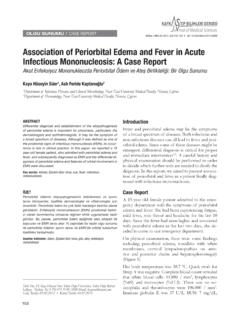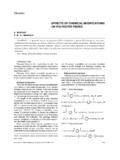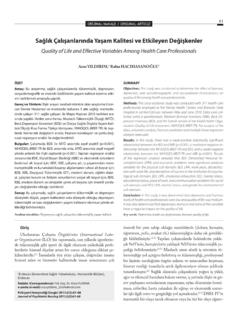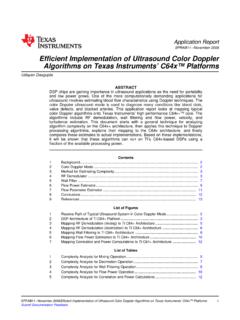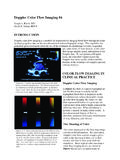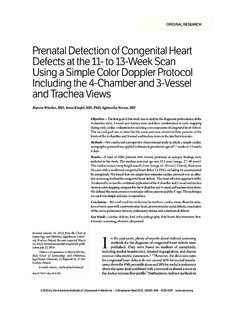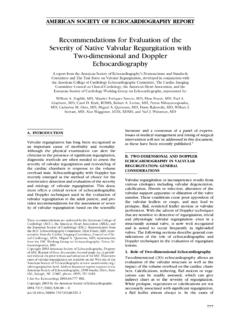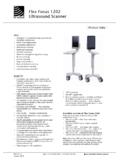Transcription of Doppler ultrasonography in lower extremity peripheral ...
1 T rk Kardiyol Dern Ar - Arch Turk Soc Cardiol 2013;41(3):248-255 doi: ultrasonography in lower extremityperipheral arterial diseaseAlt ekstremite periferik arter hastal nda Doppler ultrasonografiDepartment of Radiology, Mevki Hospital, Ankara;#Departments of Internal Medicine and Geriatrics, Gulhane Military Academy, AnkaraSamet Verim, , lker Ta , # zet Sistemik ateroskleroz ya ile paralel olarak ilerleyen, ya am kalitesini ve s resini azaltan bir durumdur. Alt ekstre-mite periferik arter hastal (PAH) sistemik aterosklerozun ya l da olduk a s k g r len bir yans mas d r. Alt ekstremite-lerde hareket k s tl l na ve t m fonksiyonlar nda azalmaya neden olmaktad r. Bu hastal olan ki ilerde koroner kalp hastal ve inme a s ndan 2-4 kat daha fazla risk bulunmak-tad r. Klodikasyon tek ba na tan amac yla kullan ld nda ya l larda daha fazla olmak zere t m olgularda PAH y g s-termede g venilmez bir i arettir.
2 Lerleyen ya ile bel omurlar ve evresel eklemlerde meydana gelen dejeneratif de i iklik-ler tipik klodikasyonun tan mlanmas n da zorla t rmaktad r. Doppler ultrasonografi (USG) alt ekstremite arterlerinin g -r nt lenmesinde kullan lan, kolay ula labilir ve invaziv olma-yan bir g r nt leme y ntemidir. Bu yaz da Doppler USG nin PAH tan s n koymadaki yeri kan ta dayal olarak tart ld . PAH ya ili kin g ncel k lavuzlarda Doppler USG nin kullan m ile ili kili eski ve yeni neriler g zden ge Systemic atherosclerosis is a condition which progresses with age, decreases quality of life, and life ex-pectancy. lower extremity peripheral arterial disease (PAD) is a common manifestation of systemic atherosclerosis in the elderly. These individuals have a 2 to 4 fold higher risk of coronary heart disease and stroke. In addition, systemic atherosclerosis causes overall functional disability including restricted lower extremity movements.
3 When used alone for diagnostic purposes, claudication is an unreliable sign of PAD in all age groups especially the elderly. Moreover, claudication is difficult to define due to the advancing age and degenerative changes in lumbar and peripheral joints. Doppler ultrasonography (US) is an easily available and noninvasive means of arterial visualization in the lower ex-tremities. In this review, supporting evidence for the use of Doppler US in the diagnosis of PAD will be discussed. Past and present recommendations regarding Doppler US in the current PAD guidelines will be of the chronic illnesses that are associated with increased age and prolonged lifespan are more frequently accompanied by significant changes in the vascular system. Narrowing and occlusions oc-cur not only in coronary and cerebral arteries, but also in the aorta and in its branches as a result of the athero-sclerotic process.
4 This condition is called peripheral arterial disease (PAD) or peripheral arterial occlusive disease . In addition, arterial stenosis of the lower limbs is generally symmetrical and most commonly occurs in the adductor canal (Hunter s canal).[1] However, the distal part of leg and foot is less seriously affected by atherosclerosis since the popliteal artery is rich in blood supply due to collateral arte-rial system of the lower extremities begins at the level of aortic bifurca-tion. Thereafter, it reaches the tiptoe by following the order of external iliac artery, and ending with the dorsalis pedis artery. When examining the arteries of the lower extremities, the collaterals that develop in the presence of occlu-sion and anatomic variations should also be examined with :ACC American College of CardiologyAHA American Heart AssociationCA Catheter angiographyCTA Computerized tomography angiographyCW Continuous waveMRA Magnetic resonance angiographyPAD peripheral arterial diseasePSV Peak systolic velocityVR Velocity ratioReceived: January 29, 2013 Accepted: April 02, 2013 Correspondence: Dr.
5 Samet Verim. Mevki Hastanesi, Radyoloji Servisi, D kap , : +90 312 - 310 35 35 e-mail: 2013 Turkish Society of CardiologyArterial pathologies may be studied in two ma-jor categories: (1) occlusive arterial diseases and (2) non-occlusive arterial diseases. In the next part of this review, we will address the diagnostic value of Dop-pler ultrasound (US) in the chronic occlusive arterial disease of the lower limbs, its place in the current guidelines, and its limitations. One of the most impor-tant characteristics of the lower extremity PAD is that it indicates presence of disseminated and significant atherosclerosis in an affected subject.[2] The presence of PAD classifies an individual in the group of cardio-vascular disease . In this case, blood pressure, glucose and lipid targets, quality of life expectations as well as prognostic approaches vary incidence of occlusive arterial diseases of the lower extremities increases with age regardless of the presence of other risk factors for cardiovascular disease .
6 When surveys from different countries are considered, the prevalence of the disease in the gen-eral population is about 3-10%, reaching the level of 15-20% after the age of 70.[3,4] This suggests that the occlusive arterial disease of the lower extremities is largely the problem of elderly. The prevalence of lower extremity PAD in Turkey was first investigated in the CAREFUL study.[5] In this multicenter national survey, subjects aged above 70-years-old or subjects aged 50-69 years with at least one cardiovascular risk factor were enrolled. The CAREFUL study con-cluded that overall prevalence of ankle brachial index and PAD was 20% in the study population and the frequency was similar in both genders. The preva-lence of the disease was above 30% in subjects older than 70 years of age indicating a marked increase compared to aging. A recent multicenter study in an Aegean area in Turkey showed the prevalence of low ankle brachial index as and in men and woman, respectively.
7 [6] When the authors defined the lower extremity PAD as either having a low ( ) or high ( ) ankle brachial index value, the frequency of the disease was calculated as However, a similar but single-center study conducted in the set-ting of internal medicine outpatient care at a tertiary hospital in Ankara determined a mean prevalence of 5% in subjects above 50-years-old.[7] One out of every five individuals above 40 years old among the Turkish adults could be regarded as having occlusive arterial disease of the lower extremities. These variations may be explained by several reasons.[8-11] Since the recog-nition of age related functional deficits in the lower extremities is frequently complicated by a multi-etio-logical course, the diagnosis of lower extremity PAD becomes more important when its asymptomatic na-ture is considered. Imaging methods in PADC atheter angiography (CA) is recommended as the reference standard in the diagnosis of PAD.
8 [12] How-ever, the potential disadvantages of this method in-clude requirement of vascular access, risk of ionizing radiation and exposure to contrast agent. Magnetic resonance angiography (MRA), computerized tomog-raphy angiography (CTA) and Doppler US are the currently the alternative imaging methods. Although, these tool are less invasive compared to CA, concerns related to the use of ionizing radiation still remain with CTA. In addition, the use of contrast substance has po-tential risks in angiography performed with CTA or MRA. However, performing Doppler ultrasonography possess neither of these risks. Therefore, it is impor-tant to examine the true value of the Doppler US in the diagnostic examination of PAD in the lower principles of the Doppler US Doppler technique was first described by the Austra-lian physicist and mathematician, Christian Doppler . The Doppler Effect is defined as the return of a high-frequency sound wave with a different frequency when it encounters a moving structure in the vessel.
9 The waves towards the transducer are coded with red and the waves moving away from the transducer are coded with blue. Main Doppler types may be classi-fied as follows; i) Continuous wave (CW) Doppler , ii) Spectral (Pulse) Doppler , iii) Color Doppler , and iv) Power Color the lower extremity , arterial Doppler ultrasonog-raphy B-mode images are obtained initially allowing a clear evaluation of anatomic structures and atheroma-tous plaques. In a normal lower extremity artery, there is a three-phase flow pattern, also called triphasic flow pattern. First, a high velocity flow results from the cardiac cycle, then an inverse flow occurs in the early diastole which is followed by a progressive flow ve-locity in the late diastole.[13] This triphasic waveform is characteristic of arteries supplying muscular bed, which has high peripheral resistance. During exercise or transient ischemia, there is loss of triphasic pattern (Fig.
10 1a). In occlusive arterial diseases, flow veloc- Doppler ultrasonography in lower extremity peripheral arterial disease249ity is increased in the region where the lumen is nar-rowed. Conversely, vascular resistance is decreased as a result of collateral circulation and vasodilation in the distal part of the obstruction. As the disease progresses, the triphasic flow diminishes to a biphasic flow (Fig. 1b). This is due initially to the loss of elas-tic recoil caused by hardening of the arteries. If the disease progresses further, the flow loses its pulsatile nature to a monophasic signal with increased diastolic flow owing to regional vasodilation (Fig. 1c).Using ultrasound, the degree of arterial disease in the lower extremities is classified into 4 categories, including 1) normal (0% stenosis), 2) 1-49% stenosis, 3) 50-99% stenosis, and 4) total occlusion (100% ste-nosis).[14] Velocity criteria for the assessment of lower limb arterial stenosis are based on the peak systolic velocity (PSV) and velocity ratio (VR) when the flow velocity is normal PSV is lower than and VR is :1.



